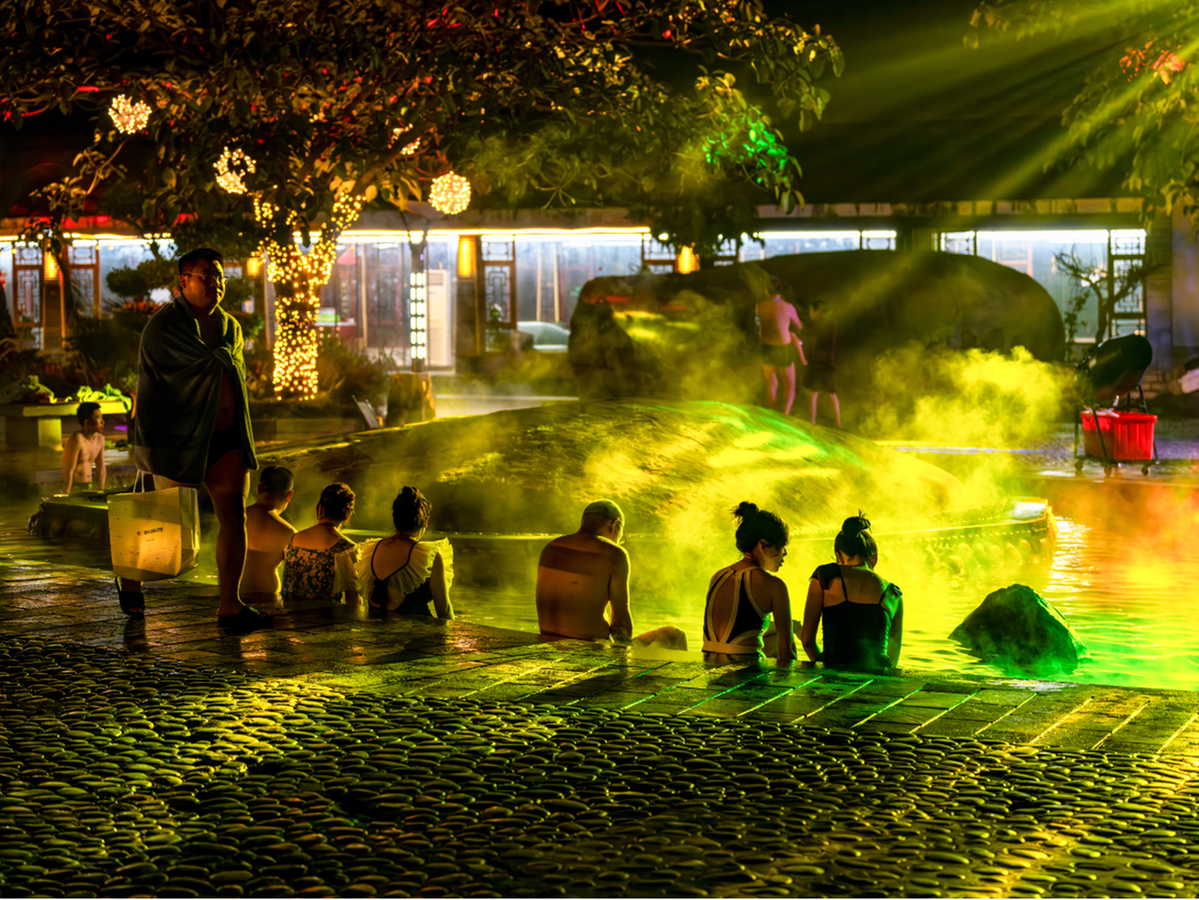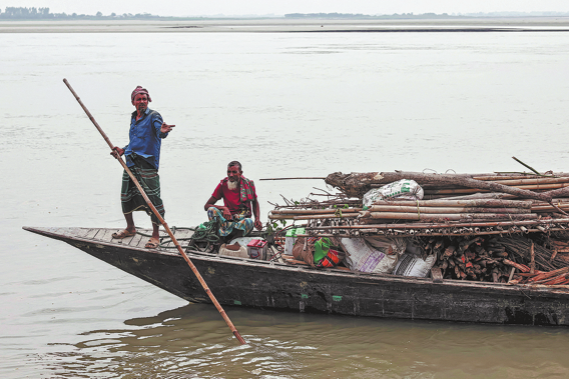Hot spring tourism sizzles in icy climes
More Chinese opting to savor experience, looking to escape daily life pressures, rejuvenate mind and body
By WANG KEJU | China Daily | Updated: 2024-02-06 10:11

As winter tightens its icy grip, hot spring getaways are growing in popularity across China.
From bathhouses in bustling cities to hot spring resorts in serene rural areas, an increasing number of individuals are seeking the soothing embrace of these warm retreats during the chilly season.
Opting for multifunctional hot spring venues, immersing oneself in warm waters, savoring delectable cuisine and beverages, and experiencing a blissful contrast of hot and cold — businesses in the hot spring industry are investing in innovative concepts and experiences to attract a diverse range of customers, according to analysts.
Travel portal Tuniu said in a recent report that consumer interest in hot spring tourism has experienced remarkable growth since November, with monthly keyword searches related to hot springs more than doubling compared to October.
The three-day New Year holiday saw an unprecedented demand in ride-hailing for destinations such as hot springs and bathhouses, with a staggering 2,000 percent year-on-year increase, data from online ride-hailing company Didi Chuxing showed.
Cities like Beijing, Harbin in Heilongjiang province, and Dalian in Liaoning province experienced a surge in demand for transportation to these spots, witnessing a several-fold growth in ride-hailing requests for those seeking a relaxing hot spring retreat, according to the data.
As the weather turns colder, individuals are actively seeking ways to relax and indulge in wellness experiences.
Hot springs, with their therapeutic properties and serene ambience, have emerged as a favored choice for those looking to escape the pressures of daily life and rejuvenate their mind and body, said Zhu Keli, founding director of the China Institute of New Economy.
Once considered a simple bathing activity, hot springs have undergone a transformation to emerge as a new form of social experience that integrates various functions such as dining, karaoke and gaming, among others.
This has redefined the way people enjoy hot springs, and turned them into hubs of relaxation, socializing and holistic entertainment, attracting younger people, Zhu added.
Zhou Yang, a 29-year-old Beijing resident, was intrigued by the overwhelming online posts about bathhouses where people could immerse themselves in hot springs while enjoying a range of additional activities.
She decided to give it a try on a Saturday in mid-January, as the allure of hot springs' therapeutic waters, coupled with an all-in-one entertainment and relaxation experience, proved irresistible.
However, upon entering the lobby, Zhou and her friends were taken aback as the hall was jam-packed, with long waiting lines stretching in front of them.
Zhou and her friends' determination to experience the hot springs outweighed the inconvenience, prompting them to wait about an hour for their turn.
"These new hot spring bathing centers provide a comprehensive range of services that go beyond mere relaxation, including movie screenings, gaming facilities, indoor playgrounds and buffet dining," Zhou said. "The most appealing part for me is the concept of 'fruit freedom', allowing patrons to enjoy unlimited pricey fruit offerings such as durians and cherries."
Young consumers, specifically those born in the 1990s and 2000s, make up more than half of the hot spring market, data from Chinese travel agency ly.com showed.
With rates starting at 300 yuan ($41.7) per visit for such bathhouses, indulging in a session at an all-inclusive bathhouse is not cheap at all, Zhou said. Higher-end establishments often charge more for premium services and exclusive amenities, she added.

Social experience
The hot spring industry in China generally maintained a revenue level of about 250 billion yuan during 2018-22, with the exception of 2020 when earnings were a meager 105.95 billion yuan due to the COVID-19 pandemic, according to data from ocn.com.cn, a Shenzhen-based consulting platform.
The evolution of hot springs into a new social experience has not only enhanced the visitor experience, but also attracted a wider demographic.
Families, friends and even corporate groups now view hot springs as a destination that offers something for everyone, said Bo Wenxi, chief economist at marketing firm Interpublic Group.
Moreover, while the northern region of China has traditionally been known for its bathhouse culture, data from Tuniu suggests that people from southern China are increasingly embracing hot spring tourism as a preferred leisure activity.
In November, more than 70 percent of hot spring bookings were made by users from southern regions.
Among them, Nanjing and Suzhou in Jiangsu province, Hangzhou and Wenzhou in Zhejiang province, and Guangzhou and Shenzhen in Guangdong province, as well as Shanghai, ranked high in terms of booking popularity, according to Tuniu.
Nestled in Northeast China's Heilongjiang province, Harbin, one of the nation's chilliest cities, has attracted droves of domestic visitors from warmer climes in the past weeks, especially those eager to experience the unique bathing culture and traditions that the city has to offer.
Data from e-commerce platform Meituan showed that during the New Year holiday, "bathhouse "emerged as the top trending search term in Harbin, with search volumes increasing by a remarkable 375.5 percent compared to the same period the previous year.
In addition, the transaction volume of bathhouses in Harbin experienced a significant year-on-year growth of 404.6 percent, while order volume and the number of users engaging in bathhouse visits increased by 324.1 percent and 331.1 percent, respectively.
"In order to avoid peak hours and long lines, my friends and I headed straight to a bathhouse that is highly recommended on social media platform Xiaohongshu — first thing upon landing," said Chen Jiaxin, a 28-year-old insurance broker based in Hong Kong, who traveled to Harbin in mid-January.
The city's cold climate provides the perfect backdrop for enjoying a relaxing and rejuvenating bathing experience, making it a popular choice for southern Chinese residents, who are accustomed to relatively moderate winters, to indulge in a hot bath or sauna in the freezing cold weather, Chen added.
As more individuals prioritize their well-being and seek holistic experiences, the demand for hot spring activities is expected to grow.
This presents an opportunity for businesses to tap into this lucrative market by providing innovative services that cater to the evolving needs and preferences of consumers, said Bo of Interpublic Group.
However, it is equally important to acknowledge that hot spring tourism exhibits a certain degree of seasonality, with fluctuations in demand based on the time of year, experts cautioned.
The seasonal nature of hot springs poses challenges for businesses operating in this sector.
The need to manage fluctuating demand requires careful planning and strategic approaches to ensure steady revenue streams throughout the year, said Wu Ruoshan, a visiting researcher at the Chinese Academy of Social Sciences' Tourism Research Center.
For instance, hot spring venues could introduce indoor thermal pools, spa treatments, wellness programs or cultural experiences to attract visitors during the months when outdoor activities may be less desirable.
By expanding their range of services, hot spring businesses can cater to a broader customer base and maintain a more consistent level of demand throughout the year, Wu said.
Furthermore, collaboration with other tourism sectors can be beneficial in addressing seasonality challenges.
Partnering with local attractions, hotels or tour operators to create bundled packages or joint marketing initiatives can help attract tourists to hot springs even during slower periods, Wu added.
wangkeju@chinadaily.com.cn
























